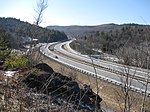Spring Hill Farm (Lebanon, New Hampshire)
Farms on the National Register of Historic Places in New HampshireFederal architecture in New HampshireHouses completed in 1799Houses in Grafton County, New HampshireHouses on the National Register of Historic Places in New Hampshire ... and 2 more
Lebanon, New HampshireNational Register of Historic Places in Grafton County, New Hampshire

Spring Hill Farm is a historic farm at 263 Meriden Road in Lebanon, New Hampshire. Founded in the late 18th century, the farm is noted for innovations in dairy farming practices introduced in the 1920s by Maurice Downs. It is also one of a small number of surviving farm properties in the town, and was listed on the National Register of Historic Places in 2002.
Excerpt from the Wikipedia article Spring Hill Farm (Lebanon, New Hampshire) (License: CC BY-SA 3.0, Authors, Images).Spring Hill Farm (Lebanon, New Hampshire)
Meriden Road, Lebanon
Geographical coordinates (GPS) Address Nearby Places Show on map
Geographical coordinates (GPS)
| Latitude | Longitude |
|---|---|
| N 43.625 ° | E -72.225277777778 ° |
Address
Meriden Road
Meriden Road
03766 Lebanon
New Hampshire, United States
Open on Google Maps







